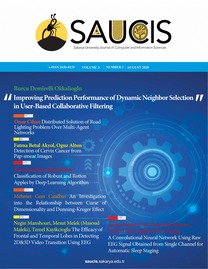A Conjoint Analysis of Propellant Budget and Maneuver Life for a Communication Satellite
___
[1] R. C. Benthem et al., “ Accuracy analysis of propellant gauging systems”, 43rd International Conference on Environmental Systems, pp. 3300, 2013.[2] R. Nariyoshi, S. Chernikov, and B. S.Yendler, “Prediction of Spacecraft Remaining Life-Challenges and Achievements”, 49th AIAA/ASME/SAE/ASEE Joint Propulsion Conference, pp. 4162, 2013.
[3] J. W. Eun, “A Study on Fuel Estimation Algorithms for a Geostationary Communication & Broadcasting Satellite”, Journal of Astronomy and Space Sciences, 17(2), pp.249-256., 2000.
[4] B. S. Yendler, M. Myers, N. Chilelli, S. Chernikov, J. Wang, A. Djamshidpour, “Implementation of Thermal Gauging Method for ABS 1A (LM 3000) satellite”, 14th International Conference on Space Operations, (p. 2458)., 2016.
[5] B. S. Yendler, J. Molinsky, S. Chernikov, D. Guadagnoli, “Comparison of gauging methods for Orbital’s GEOStarTM 1 Satellites”, SpaceOps 2014 Conference, pp.1810, 2014.
[6] B. Yendler, “Review of propellant gauging methods”, 44th AIAA aerospace sciences meeting and exhibit, p. 939, 2006.
[7] I. Oz, L. Pelenc, B. Yendler, “Thermal Propellant Gauging, SpaceBus 2000 (Turksat 1C) Implementation”, AIAA 2008-7697, San Diego, California, pp.7697, 2008.
[8] I. Oz and Ü. C. Yılmaz, “Determination of Coverage Oscillation for Inclined Communication Satellite”, Sakarya Üniversitesi Fen Bilimleri Enstitüsü Dergisi, 24(5), pp. 963-973., 2020.
[9] B. Cabrières, F. Alby, C. Cazaux, “Satellite end of life constraints: Technical and organisational solutions”, Acta Astronautica, vol.73, pp. 212-220, 2012.
[10] J. Fu, X. Chen, , Y. Huang, “Uncertainty Analysis of Propellant Compression Mass Gauge for Spacecraft”, Procedia Engineering, 31, pp.122-127, 2012.
[11] S. Côté, S., K. Srivastava, P. Le Dantec, R. Hawkins, K. Murnaghan, ” Anik E Spacecraft Life Extension”, Space OPS 2004 Conference, pp. 208., 2004.
[12] A. Aparicio, B. Yendler, “Thermal propellant gauging at EOL, Telstar 11 implementation” , SpaceOps 2008 Conference, pp. 3375, 2008.
[13] W. Yin, Z. Cao, Z. Lin, “Research on Combination of Multiple Methods for Spacecraft Propellant Consumption Prediction”, IOP Conference Series: Materials Science and Engineering, Vol. 887, No. 1, pp. 012039 IOP Publishing., 2020.
[14] A. Lal, B. N. Raghunandan, “Uncertainty analysis of propellant gauging system for spacecraft”, Journal of Spacecraft and Rockets, 42(5), pp. 943-946., 2005.
[15] E. M Soop, W. R. Burke, “Introduction to geostationary orbits”, STIN, 84, 21590., 1983.
[16] A. Grise, T. Douglas, “Maximization of satellite lifetime: Telesat Canada's experience”, SpaceOps 2006 Conference, pp. 5906, 2006.
- ISSN: 2636-8129
- Yayın Aralığı: Yılda 3 Sayı
- Başlangıç: 2018
Effect of the Chaotic Crossover Operator on Breeding Swarms Algorithm
Hüseyin DEMİRCİ, Nilüfer YURTAY
Deep Neural Networks Based on Transfer Learning Approaches to Classification of Gun and Knife Images
Mehmet Tevfik AĞDAŞ, Muammer TÜRKOĞLU, Sevinç GÜLSEÇEN
A Study on the Efficacy of Deep Reinforcement Learning for Intrusion Detection
Halim Görkem GÜLMEZ, Pelin ANGİN
Halil İbrahim CEBECİ, Yasemin KORKUT
A Conjoint Analysis of Propellant Budget and Maneuver Life for a Communication Satellite
Performance Assessment of a Turn Around Ranging in Communication Satellite Orbit Determination
İbrahim ÖZ, Ü. Cezmi YILMAZ, Ümit GÜLER
Performance Evaluation of MANET Routing Protocols AODV and DSDV Using NS2 Simulator
Amenah Sufyan MHMOOD THABER, Ahmet ZENGİN
Sentiment Analysis on Social Media Reviews Datasets with Deep Learning Approach
